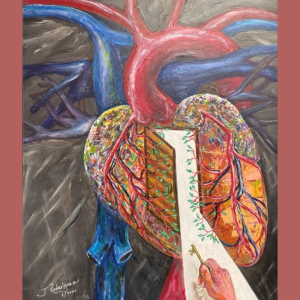Intravascular Ultrasound
Intravascular ultrasound (IVUS) is a medical imaging technique that allows for the visualization of blood vessels from the inside. It involves the use of a tiny ultrasound probe that is threaded into the blood vessels through a catheter, providing detailed images of the vessel walls and structures.
Here’s how intravascular ultrasound works and why it is used in clinical practice:
Procedure:
Insertion of the Catheter:
A catheter, which has a small ultrasound probe at its tip, is inserted into a blood vessel, typically through the groin or the arm. The catheter is carefully guided through the blood vessels until it reaches the area of interest.
Ultrasound Imaging:
Once the catheter is in place, high-frequency sound waves are emitted from the ultrasound probe. These sound waves bounce off the vessel walls and other structures inside the blood vessel.
Image Capture:
The reflected sound waves are picked up by the probe and converted into real-time images. These images are then displayed on a monitor and can be recorded for further analysis.
Benefits and Applications of Intravascular Ultrasound:
Detailed Visualization:
IVUS provides high-resolution, cross-sectional images of blood vessels, allowing vascular surgeons to assess the vessel size, structure, and any abnormalities present. IVUS provides more detailed information compared to other imaging techniques.
Assessment of Atherosclerosis:
IVUS is commonly used in the evaluation of atherosclerosis, a condition characterized by the buildup of plaque inside the arteries. Intravascular ultrasound also helps determine the extent and composition of the plaque, identify areas of vessel narrowing or blockage, and guide treatment decisions.
Guidance for Interventions:
IVUS is often utilized during various vascular procedures, such as angioplasty or stent placement. IVUS provides real-time feedback to guide the placement of devices and assess their effectiveness in improving blood flow.
Assessment of Stent Deployment:
IVUS can evaluate the proper positioning and expansion of stents within the blood vessels. IVUS helps ensure that the stent is fully expanded and properly apposed to the vessel walls, reducing the risk of complications.
Research and Clinical Trials:
Intravascular ultrasound is also utilized in research studies and clinical trials to investigate new treatment approaches, assess the effectiveness of medications, and gather data on vascular conditions.
IVUS is a valuable tool in the field of vascular medicine. It helps vascular surgeons make accurate diagnoses, guide treatment decisions, and monitor the progress of interventions. The information obtained through IVUS enhances patient care by providing detailed insights into the condition of the blood vessels, allowing for personalized treatment plans and improved outcomes.























